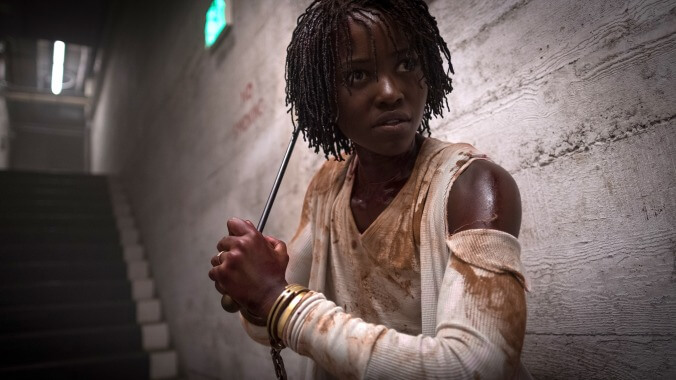In the weeks since Jordan Peele’s Us hit theaters we’ve all done what most moviegoers do these days: obsessively dissect every frame and detail for hidden clues and deeper meaning. The internet has already collected every easter egg in the horror hit, shared the most intriguing and absurd fan theories—sorry, but we just can’t get on board with that Pluto/Jason theory—and explained the ending ten times over. Peele has also shed some light on a few elements, but now he’s provided more insight on the meaning behind the ending and that final twist.
Now’s a good time to stop reading if you haven’t seen Us yet, and somehow miraculously managed to avoid spoilers. In the film’s final moments, as Adelaide (Lupita Nyong’o) and her family flee from the chaos at Santa Cruz, a flashback reveals Adelaide and her Tethered self Red switched places years ago inside the hall of mirrors. The above-ground Adelaide we’ve been following all along is actually Red, while the “real” version of Nyong’o’s character is the one who’s been plotting to get justice in the tunnels below.
Now, it’s not exactly a surprising twist, considering that Peele peppers his film with rather obvious clues alluding to the switch from the jump. (And honestly, it’s debatable whether the moment should be considered a “twist” at all, but that’s a discussion for another time.) But still, what does it all mean to Peele? Luckily, he’s the type of filmmaker willing to explain his movies—or maybe not luckily if you prefer the Lynchian camp of directors who refuse to explain—so he dropped by The Empire Film Podcast (h/t Uproxx) to share his take on that ending.
“This movie’s about maybe the monster is you,” Peele told Empire’s Chris Hewitt when asked to break down the ending. “It’s about us kind of looking at ourselves as individuals and as a group. The protagonist in a movie is the surrogate for the audience. So it felt like, at the end of the day, I wasn’t doing my core theme any justice if I wasn’t revealing that we have been the bad guy in this movie. We’ve been following the villain.” Peele added that he uses “villain” lightly, since Us is interested in raising questions around what differentiates good from evil, and they ways in which we perceive otherness through the Tethered and Untethered.
Peele also spoke about that much-discussed look Adelaide shoots Jason at the end of the film. “I think the little smile she gives him is a lot of things,” he said. “I think it’s a connection to the evil smile she once had as a little girl, but also a sort of understanding that her family unit was stronger from this experience.”
If you’re still itching for more Us analysis, head to Empire to listen to the full episode.

